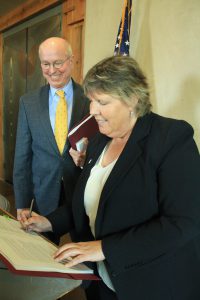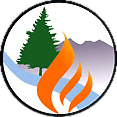Flagstaff Watershed Protection Project’s Biannual Report summarizes accomplishments in Project Planning, Implementation, Outreach, Monitoring, Tribal Engagement and Financial Leverage from Jan.-June 2015. For full report see Biannual Report July-Dec 2015_Final
Flagstaff Watershed Protection Project: Creating Solutions through Community Partnerships – ERI White Paper
This case study spans the first two years of the Flagstaff Watershed Protection Project (FWPP) and intends to convey to other communities, municipalities, and/or government agencies the administrative functions and mechanisms used by the City of Flagstaff and the U.S. Forest Service to develop and implement FWPP. The paper is designed as a case study for others considering a similar initiative. For full report, click here: FWPP – Creating Solutions Through Community Partnerships.
FWPP Final Record of Decision signed Oct 22

City of Flagstaff Mayor Jerry Nabours looks on as Laura Jo West, Coconino National Forest Supervisor, signs the final Record of Decision for the project’s Environmental Impact Statement
Flagstaff, AZ – On October 22, the Flagstaff Watershed Protection Project reached another significant milestone when Coconino National Forest Supervisor Laura Jo West signed the final Record of Decision for the project’s Environmental Impact Statement. A Signing Ceremony was held for partners and collaborators to celebrate this achievement. This project is unique in its origin and funding, as it was proposed by the City and is funded by a municipal bond approved by voters in 2012.
– Read to the end for information on what to expect for implementation –
Since 2013, implementation of fuels reduction treatments have been completed and will continue in areas within FWPP boundaries on City and State lands, as well as National Forest lands that were approved through previous National Environmental Policy Act (NEPA) analyses. This final Record of Decision approves treatments on the remainder of the National Forest lands within the FWPP boundary – the majority of the project area – including use of novel harvesting methods to reduce hazardous fuels on the steep slopes above Flagstaff’s key watersheds.
The Decision includes treatment of 8,669 acres through a combination of mechanical thinning, hand thinning, and prescribed burning. Prescribed fire will occur on all 8,669 acres, which includes approximately 870 acres that will receive only fire treatments. Traditional, ground-based harvesting equipment will be used for the most of the thinning (5,817 acres). Helicopter and cable logging will occur on small portions of the project area (566 and 414 acres respectively). These treatments will begin next year. Prep work – including marking trees, improving roads, and preparing contracts – will begin this fall and winter in the Dry Lake Hills area.
“This is a monumental occasion of which the entire community should be proud,” says Laura Jo West, Coconino National Forest Supervisor. “We’re at this point today because of the incredible collaboration among all the partners and the tremendous support we’ve received from the community. We got here together, and we’re excited to continue working together in the next chapter of this exceptional project.”
Though prep work is less noticeable than harvesting, the public should still expect to see increased activity in the forest over the next several months.
- Crews will be marking trees this fall and winter in the Dry Lake Hills area in preparation for implementing Phase 1 of the project next summer.
- Trees painted with orange indicate these trees are “leave trees” and will not be not cut; however, in some areas blue paint may be used to indicate trees that will be removed. Efforts will be made to minimize markings within viewsheds of roads, trails, and recreation sites.
- Thinning efforts on City, State, and National Forest lands will continue throughout the project area. This includes small-scale demonstrations of equipment on steep slopes and harvesting in the 891-acre Orion Task Order which is within the FWPP and will be carried-out through the Four Forest Restoration Initiative Phase One Stewardship Contract held by Good Earth Power, LLC.
- Smoke from prescribed fires will be noticeable from the Flagstaff area. The Coconino NF provides notifications of Forest Service prescribed fires, which can be found on the forest website at coconinonationalforest.us.
The Forest Service and City of Flagstaff developed an implementation plan that outlines the general timeline for FWPP treatments to occur. It separates thinning into three phases to maximize efficiency while limiting impacts to aesthetics, recreation, and threatened and endangered species.
- Thinning Phase 1: 1,428 acres. This phase will include treatments on the lower slopes of the Dry Lake Hills north of Flagstaff. Ground-based mechanical harvesting methods will be used. Prep work in these areas will occur this fall and winter, with harvesting expected to begin in 2016.
- Thinning Phase 2: 3,810 acres. This phase will occur on the steep slopes of the Dry Lake Hills and includes treatments that require specialized equipment such as helicopter and cable logging and steep-slope harvesting equipment. Phase 2 also includes thinning in Mexican spotted owl Protected Activity Centers (PACs) and northern goshawk post-fledging family areas (PFAs), and will be completed in as short a timeframe as possible to limit the duration of impacts. Prep work is expected to occur in 2016 and 2017, with harvesting estimated to begin in 2017 or 2018.
- Thinning Phase 3: 2,975 acres. This phase covers all the treatments in the Mormon Mountain portion of the FWPP, south of Flagstaff near Lake Mary. Prep work is planned to occur in 2017 and 2018, with harvesting activities expected to begin in 2019.
- Prescribed fire treatments will occur as conditions allow, typically in the fall and spring.
The City of Flagstaff, the USDA Forest Service, and the State of Arizona continue to make FWPP a top priority and will continue to provide the public with updates on the project that Flagstaff voters approved.
The Implementation Plan, EIS, and Record of Decision are available on the Forest Service project website at click here
Summary of Draft Record of Decision
This summary explains the how, when, what and why of the Flagstaff Watershed Protection Project’s draft Record of Decision. The summary also includes relevant reference websites and tables that describe treated acres and corresponding harvesting methods, post-treatment fire
hazard results, and predicted soil burn severity maps. See the FWPP DROD Summary for details.
Release of the Draft Record of Decision for FWPP
The Coconino National Forest announces Scott Russell, Acting Forest Supervisor, has signed the draft Record of Decision (ROD) for the Flagstaff Watershed Protection Project!
Russell said, “We listened to the concerns brought forth during the DEIS comment period and have not only incorporated but also relied on public input in the formation of this decision. The draft ROD will meet the purpose and need for the project while also addressing concerns related to large tree retention, effects on the viewshed of Flagstaff, and impacts to the Mexican spotted owl.”
The draft ROD and Final Environmental Impact Statement (FEIS) as well as the Response to Comments on the Draft Environmental Impact Statement (DEIS) and an Implementation Plan are now available on the Forest Service (USFS) project website here: www.fs.usda.gov/goto/FWPP.
A legal notice of the availability of the draft ROD and FEIS is anticipated to print in the Arizona Daily Sun on June 26, which will mark the start of the 45-day objection period. A copy of the legal notice will be posted on the USFS website above. Once the objection period ends, the USFS will go through a 45-day objection resolution period. After the objections are resolved, the USFS can issue a final Record of Decision, anticipated September 2015, and begin implementation. You can also find the Implementation Guide on the website above for more information about the implementation phases, estimated timelines, and steps necessary to implement and administer a timber contract.
If you have any questions about the project, the draft decision, the comment period or the FEIS, please feel free to contact FWPP USFS Project Manager, Erin Phelps, at (928) 527-8240 or by e-mail: ephelps@fs.fed.us.
FWPP Biannual Report January-June 2015
Flagstaff Watershed Protection Project’s Biannual Report summarizes accomplishments in Project Planning, Implementation, Outreach, Monitoring, Tribal Engagement and Financial Leverage from Jan.-June 2015. For full report see Biannual Report Jan-June 2015_Final
EVALUATING EROSION RISK MITIGATION DUE TO FOREST RESTORATION TREATMENTS USING ALLUVIAL CHRONOLOGY AND HYDRAULIC MODELING
New Monitoring Report Complete: Schultz Creek is a major tributary of the Rio de Flag watershed of the City of Flagstaff, Arizona, which is being treated by the FWPP. This study used alluvial chronology to study the recent geologic history of Schultz Creek and hydraulic modeling to predict how peak flood flow magnitudes and stored sediment could be affected by severe wildfires and FWPP treatments in and adjacent to Flagstaff, Arizona. Click here Fullthesisdec10 for full report.
FWPP Biannual Report July-Dec 2014
FWPP’s Biannual Report summarizes accomplishments in Project Planning, Implementation, Outreach, Monitoring, Tribal Engagement, and Financial Leverage from July-Dec. 2014. Click here for the full report: Biannual Report July-Dec 2014_Final_1-21-15
Open Letter to the Community
As the Flagstaff Watershed Protection Project continues to move forward, Paul Summerfelt, FWPP Project Manager for the City of Flagstaff, would like to share an update on recent FWPP accomplishments and efforts currently underway to protect our community and surrounding forest. To learn more please view FWPP Open Letter_Nov 14
Equestrian Project – Post Treatment Survey Results
Prior of implementation of the FWPP Equestrian Forest Management Project, residents in Equestrian Estates and University Heights adjacent to the project were mailed notice of the pending 400 acre project which occurred August-September 2014. This project, the first mechanical removals as part of the FWPP, was widely accepted and greatly appreciated by area residents who have recognized the necessity to conduct these much needed forest treatments to protect their neighborhoods and the greater Flagstaff community. Following completion of the project, a second letter with a survey was mailed to these residents asking for their opinion on the project and its benefits. View FWPP Equestrian Project Survey_SUMMARY to see a summary of the survey results and comments provided by respondents.

